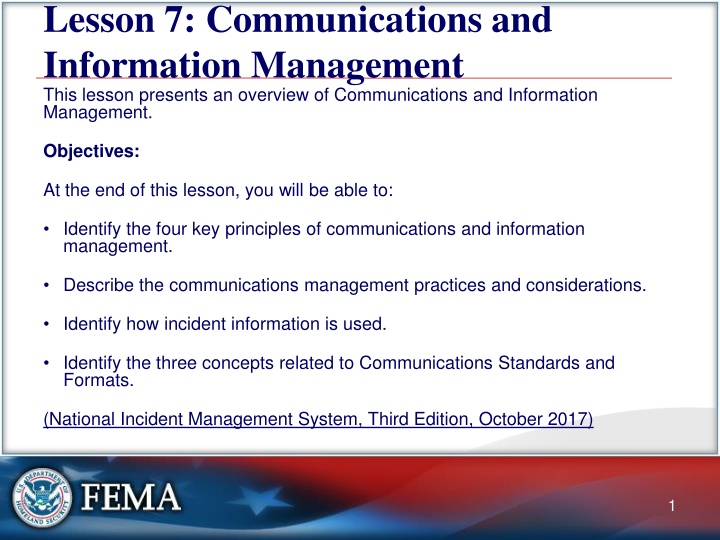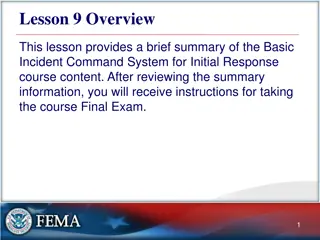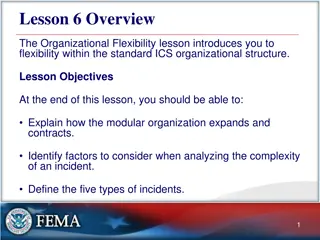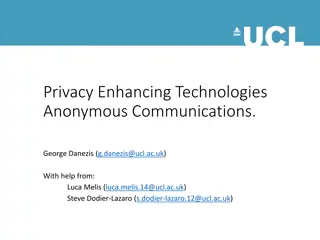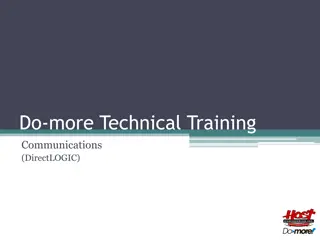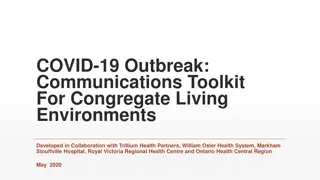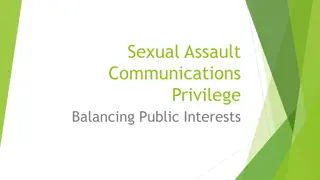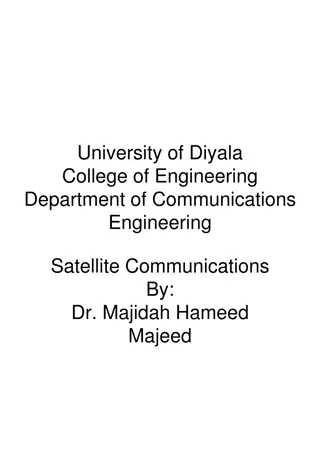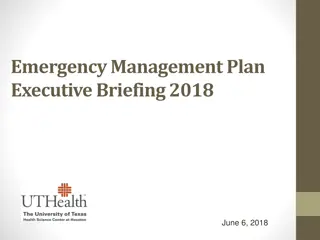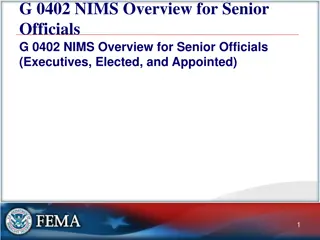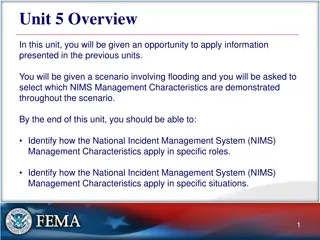Principles of NIMS Communications and Information Management
Effective emergency response relies on maintaining situational awareness through constant flow of information. This lesson covers key principles including interoperability, reliability, scalability, and portability for communication and information management in incidents. It emphasizes the need for flexible systems that provide accurate, timely, and relevant information to all personnel involved. The integration of these principles enables incident managers to manage information effectively during incidents.
Download Presentation

Please find below an Image/Link to download the presentation.
The content on the website is provided AS IS for your information and personal use only. It may not be sold, licensed, or shared on other websites without obtaining consent from the author.If you encounter any issues during the download, it is possible that the publisher has removed the file from their server.
You are allowed to download the files provided on this website for personal or commercial use, subject to the condition that they are used lawfully. All files are the property of their respective owners.
The content on the website is provided AS IS for your information and personal use only. It may not be sold, licensed, or shared on other websites without obtaining consent from the author.
E N D
Presentation Transcript
Lesson 7: Communications and Information Management This lesson presents an overview of Communications and Information Management. Objectives: At the end of this lesson, you will be able to: Identify the four key principles of communications and information management. Describe the communications management practices and considerations. Identify how incident information is used. Identify the three concepts related to Communications Standards and Formats. (National Incident Management System, Third Edition, October 2017) 1
What Is NIMS Communications and Information Management? Effective emergency response depends on communication the ability to maintain situational awareness through the constant flow of information. 2
Communications and Information Management Introduction In order to maintain situational awareness, incident personnel update incident information continually. Effective incident management relies on flexible communications and information systems that provide accurate, timely, and relevant information. During an incident, this integrated approach: Links all incident personnel, whether on-scene, in an EOC, or in another support location Maintains communications connectivity and situational awareness Four key communications and information systems principles support the ability of incident managers to maintain this constant flow of information during an incident: Interoperability Reliability, Scalability, and Portability Resilience and Redundancy Security 3
Interoperability Interoperability is the capacity for emergency management and response personnel to interact and work well together. Interoperable communications systems enable personnel and organizations to communicate: Within and across jurisdictions and organizations Via voice, data, and video systems In real time 4
Reliability, Portability and Scalability Communications and information systems should be designed to be: Reliable - familiar to users, adaptable to new technology and dependable in any situation Portable - can effectively be transported, deployed, and integrated to enable support of incidents across jurisdictions Scalable - able to expand to support situations, from small to large scale, and support the rapid increase in the number of system users 5
Resiliency and Redundancy Resilient and redundant communications ensure the uninterrupted flow of information. Resiliency - systems can withstand and continue to perform after damage or loss of infrastructure Redundancy - when primary communication methods fail, duplicate systems enable continuity through alternate communication methods 6
Security Because some incident information is sensitive, voice, data, networks, and systems should be secure to the appropriate level to control access to sensitive or restricted information. For example, law-enforcement may discuss sensitive, personally identifiable or classified information and must ensure this information is shielded in accordance with applicable laws. Additionally, incident communications and information sharing should comply with data protection and privacy laws. 7
Discussion Question What happens if one of these four key communication and information systems principles are not addressed or fail? 8
Communications Management Characteristics Incident management personnel must manage incident communications and information effectively using a variety of communications methods. Management procedures should change to use new technologies and improved methods of exchanging information. 9
Standardized Communications Types Successful communications and information management requires the use of standard communications types: Strategic Communications: High-level directions, including resource priority decisions, roles and responsibilities determinations, and overall incident management courses of action. Tactical Communications: Communications among and between on-scene command and tactical personnel and cooperating agencies and organizations. Support Communications: Coordination of support of strategic and tactical communications (e.g., communications among hospitals concerning resource ordering, dispatching, and tracking; traffic and public works communications). Public Communications: Alerts and warnings, press conferences. 10
Policy and Planning All stakeholders should be involved in communications planning to formulate integrated and interoperable communications plans, technology and equipment standards. Coordinated communications policy and planning supports effective communications and management of information. Communications planning determines: What communications systems and platforms are used Who can use the communications systems What information is essential What the technical requirements are for communications equipment and systems 11
Agreements Agreements should be in place between all parties in a jurisdiction's emergency operations plan to ensure that the communications elements within plans and procedures are in effect at the time of an incident. Agreements typically specify the communication systems and platforms that the parties will use to share information. Agreements also typically include connection of networks, data format standards, and cybersecurity agreements. 12
Equipment Standards Communications equipment standards are designed to produce unified communications systems. When developing communications systems, personnel should consider: The range of conditions under which personnel will use the systems. The range of potential system users. The current nationally recognized communications standards. The need for durable equipment. 13
Training Training and exercises that employ interoperable communications systems and equipment enable personnel to understand their capabilities and limitations before an incident. 14
Discussion Question Which of the following are Strategic Communications? Communications between on-scene command and tactical personnel and cooperating agencies and organizations. High-level directions, resource priority decisions, roles and responsibilities determinations, and incident management courses of action. Coordination of support of strategic and tactical communications. Emergency alerts and warnings; press conferences. 15
Incident Information During an incident, timely and accurate information assists decision making at all levels. Information is used for many functions within ICS, EOCs, MAC Groups, and JIS, including: Aiding in planning Communicating with the public, including emergency protective measures Determining incident cost Assessing the need for additional involvement of non-governmental organizations or private sector resources Identifying safety issues Resolving information requests Refer to your Student Manual for more information about Incident Reports, Incident Action Plans, and Data Collection and Processing. 16
Incident Reports Incident reports enhance situational awareness and ensure that personnel can access needed information. Types of incident reports include: Situation Report (SITREP): Regular reports that contain information regarding the incident status during the past operational period and the specific details for an incident. Status Report: Reports, such as spot reports, that include vital and/or time-sensitive information. Status reports are typically function-specific and less formal than SITREPS. Incident reports should use a common format to enable other jurisdictions and organizations to easily access incident information. 17
Incident Action Plans Incident-specific plans improve situational awareness and describe the objectives and tactics of the incident management. Incident-specific plans include: Incident Action Plan (IAP): Plans containing the incident objectives established by the Incident Commander or Unified Command and addressing tactics and support activities for the planned operational period (generally 12 to 24 hours). 18
Data Collection and Processing ICS, EOCs, MAC Groups, and JIS all rely on accurate and timely information to support decision making. When collecting data, personnel should: Follow data collection techniques and definitions Conduct analysis of data Transmit data through appropriate channels Data collection and processing include the following standard elements: 1. Initial size up/ rapid assessment 2. Data collection plans 3. Validation 4. Analysis 5. Dissemination 6. Updating 19
Discussion Question What challenges has your organization faced in incident communications? 20
Communications Standards and Formats During an incident, all incident personnel are linked by common communications standards and formats: Common Terminology, Plain Language, and Compatibility Technology Use and Procedures Information Security/Operational Security 21
Common Terminology, Plain Language, Compatibility Common Terminology: The use of common terminology helps incident management personnel communicate and coordinate. Plain Language: Personnel should use plain language and clear text; avoid using organizational acronyms or jargon such as 10-codes during incidents involving multiple organizations. Data Interoperability: Common communications protocols enable the dissemination of information among all incident management elements. 22
Technology Use and Procedures Technology provides many resources for incident management. Personnel use technology tools to increase situational awareness for both incident management and the public. Examples of communications technologies include: Radio and telephone systems Public warning and notification systems Hardware, software and internet-based systems and applications such as Geospatial Information Systems (GIS) and incident management software Social media Information transmitted through communications technologies should follow planned and standardized methods and conform to information sharing standards, procedures, and protocols. Social media provides unique considerations and tools for incident management that can support activities such as information monitoring and gathering, distributing public information and warning, producing maps and incident visualizations, and matching information resources to identified needs. 23
Information Security/Operational Security (OPSEC) Access to some types of restricted or classified information depends on applicable law as well as an individual's security clearance and need to know. The need for confidentiality can complicate information sharing and create challenges that must be resolved. For example, intelligence information that is normally restricted to use within the law enforcement community might need to be shared with emergency management, fire or public health in order to protect lives. 24
Voices of Experience: Prompting Effective Communications Kristy Plourde, Emergency Management Specialist, U.S. Coast Guard "We have HF, UHF, and VHF, all these different frequencies and radios and radio frequencies and what s neat about NIMS is NIMS is helping push everyone to change and establish better intercommunications. In the past we just kind of said, well, too bad they don t have the right radio with us so we ll just do this little inefficient method of communication by calling ashore and having the guy talk to the other guy and then have him radio back to have the boat come over and pick us up. That s very inefficient and it s very wrong, and we just kind of wave our arms and go, oh, it s just too bad. What NIMS is doing is pushing it and saying, hey, change, have this good intercommunications, have systems, electronic systems that support, you know, interfrequency variations, and establishing common frequencies that everyone can use." 25
Voices of Experience: Prompting Effective Communications Daryl Lee Spiewak, Former Emergency Programs Manager, Brazos River Authority, TX "One of the difficulties that we ve had in coordinating response is the different radio systems and the different pieces of equipment whether it is part of the Internet, computer programs, telephones, cell phones, satellite phones, whatever. If you can t talk to each other, you are not going to be able to work together. So, part of the interoperability is making sure that our equipment is compatible. We can talk. The second part of equipment compatibility is that the equipment works together. You can t take a fire truck that has a 6-inch hose and try to put it to a fire hydrant that operates with a 4-inch connector. So if I take my truck from my facility and I bring it out to help you, if I can t get the water pumped in, if I can t hook our systems together, we re not going to be able to work in a coordinated effort. Second thing is interoperability between people and organizations. Part of that is the verbal communications where I say something, use a particular term, and it means the same thing to you. If the terms that I use mean different things to different people, we re going to have a hard time communicating and doing what needs to be done to accomplish our mission. So, it s a little bit of both. The equipment, the people, and then how do people work together within the organization to accomplish those objectives and get the mission done." 26
Lesson 7: Communications and Information Management Summary The lesson presented an overview of Communications and Information Management. The lesson specifically discussed the: Key Principles of Communications and Information management Communications and Information Management Characteristics Elements of Incident Information Communication Standards and Format The next lesson will provide a summary of the information introduced in this course along with additional resources. 27
